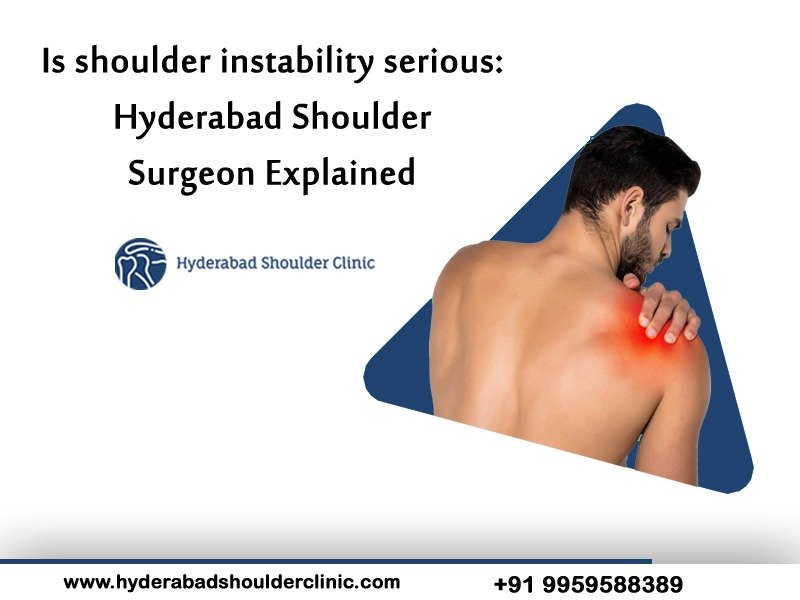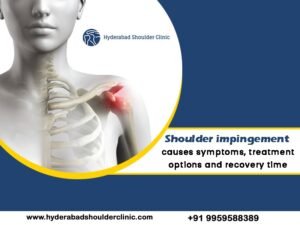Dr Chandra Sekhar, an expert doctor for shoulder injuries, and his team of trained shoulder specialists at Hyderabad Shoulder Clinic offer exceptional care for both regular and the most complex shoulder instability problems.
You can find evidence-based treatments from our team of orthopaedic doctors, whether your shoulder instability stems from an athletic injury or any other cause. As a result, your shoulder will be stabilised, and you can start playing your favourite sport as soon as possible.
What is shoulder instability?
Shoulder instability refers to a shoulder joint that is too loose and can move around more than enough in the socket. In some instances, this may cause the unstable shoulder to pop out of the socket. If the joint comes out of the socket, it is referred to as a dislocation, which requires immediate treatment.
How Does Shoulder Instability Occur?
Shoulder instability develops when the joint becomes loose and slips out of the glenoid socket. Overuse, severe injuries, or repetitive stress are common causes of this condition. If it is not treated, it turns out to be a chronic shoulder instability resulting in severe injuries, pain, or shoulder joint arthritis.

The following conditions make some people more vulnerable to shoulder instability:
Double-jointed: People with double jointedness will experience joint laxity, or looseness, which may result in shoulder instability.
A history of shoulder dislocation: People who have had shoulder dislocation in the past may develop chronic shoulder instability. This is because the ligaments and tendons supporting the shoulder joint might be damaged during the dislocation.
Sports: Athletes who are involved in playing certain sports like baseball, swimming, or volleyball are at risk of stretching out their muscles and ligaments, resulting in recurrent shoulder dislocation.
Symptoms of Shoulder Instability
- You may feel your shoulder has moved back and forth in its socket or is coming out of it when certain movements are made.
- You may or may not experience pain.
- Numb or tingling sensation down the arm.
- Everyday activities, especially swimming or pitching, might cause popping, catching, or looseness of the shoulder.
Diagnosis of Shoulder Instability
You’ll have to discuss your medical history with your doctor and the symptoms you are experiencing.
The doctor will conduct a complete physical examination. During the examination, palpation is used to detect tender spots and analyse the strength and range of motion. During the diagnosis, specific tests can assess the degree of shoulder laxity or looseness. An X-ray may be ordered to obtain the details that cause the instability and eliminate other reasons for shoulder discomfort, like fractures.
Additional diagnosis tests, like MRI scans or an arthrogram with or without a CT scan, are occasionally done to evaluate the bones and tissues in your shoulder joint. However, these scans are performed only for some patients with instability.
Treatment for Shoulder Instability
Treatment depends on many factors, such as the severity of shoulder instability.

Nonsurgical Treatment:
Conservative treatment for shoulder instability may begin with rest, anti-inflammatory medicines, and steroid injections to reduce pain.
You may need to undergo a shoulder instability rehab programme that includes physical therapy and special exercises tailored to enhance your strength and range of motion. The therapy’s major purpose is to strengthen the shoulder blade and the rotator cuff muscles to stabilise the shoulder.
Surgical Treatment:
Surgical intervention is necessary to stabilise the shoulder joint if the shoulder instability persists even after conservative treatment. For example, surgery is often required to repair a fractured arm or a large rotator cuff tear.
In most cases, shoulder instability can be fixed with arthroscopic surgery, but an open procedure might be recommended for significant bone damage.
Dr Chandra Sekhar, one of the best shoulder surgeons in Hyderabad, is an expert in minimally invasive procedures that can stabilise the shoulder joint. These include Bankart repair, also known as labral repair; Electrothermal Arthroscopic Capsulorrhaphy (ETAC), Capsular shift, Latarjet procedure, and reconstruction of the humeral head or glenoid allograft.
Post-operative Care:
- Post-operative care is very important for a faster and safe recovery.
- In the case of arthroscopic surgery, patients can go home on the same day as the surgery is an outpatient procedure
- . But in the case of open surgery, patients need to stay in the hospital for at least 1-2 days.
- The operated arm will be in a sling for about 1 month after surgery.
- Doctors suggest physical therapy and strength training exercises to regain range of motion and strength.
- Full recovery might take a few months.
If you’re looking for shoulder experts to address your shoulder problems, we can help you out. Dr Chandra Sekhar and his staff are experts in treating various shoulder problems, including shoulder joint replacement. To find out more about treatment, call +91 99595 88389 and book an appointment.





